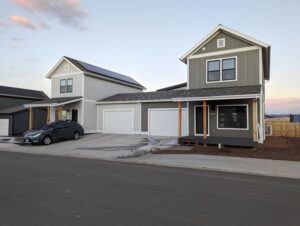
Architecture, by definition, is the art and technique of designing and building. Architecture should be a balance of art and building function, but in today’s industry, with the rising cost of building supplies, real estate, and profits, the “art” gets pushed to the side. Too often, the “art” that we present as designers is an emotionless, quick render that is generated moments before a presentation. But even a computer-generated render should be the foundation on which designers and architects lay down the spirit of the project. Post rendering production is our opportunity to engage the client emotionally with the project. When they are emotionally attached to the vision, the project becomes more than just a building: it becomes something both the designer and client can be proud of.
The process of post rendering starts with a computer-generated base. With the scene set, post rendering adds in the details like grass, asphalt, and concrete textures that help ground the image closer to reality. The render should be in a space between realistic and computer-generated. Vegetation is important to help set the building in its environment. Adding vegetation around the base of the building helps blur the harsh lines of a computer-generated image at the human level. Sharp lines help the image when used on the roof to contrast the building’s silhouette with the sky.
A good sky in a post rendering is important for setting the mood. An early morning sunrise can set the scene for showing a building waking up to house its function. A bright sunny day sets the scene for understanding the building in its neighboring environment. An evening sun or sunset is great to establish a more social side of the project. Ultimately, the sky should be used to highlight an important characteristic of the project for the given rendering.
On the topic of a good sky background, the people (entourage) used in the rendering need to have proper lighting. Understanding the position of the sun and placing shadows within the image gives the rendering a realistic feeling. Shadows are a tool to help balance the overall image. Depending on the sky the shadows should be represented accordingly. If it is a bright sunny sky, no shadows, then the shadow should be sharp. Somewhat cloudy sky then the shadow should be softer. A balance of light and shadow helps set the emotion.
Adding vegetation, a sky and good shadows are only a few post rendering edits that help create an emotional attachment. By treating rending more like art, we can help the client believe in the vision of the project, and not be driven solely by project cost. Often when we see a design that challenges “cookie cutter” design conventions, we assume the cost value to be higher than normal, but often the cost is not that different. Putting personality and emotion into a design can be more of a challenge in today’s fast-paced market, but doing so in post rendering benefits the client and the project as a whole.








